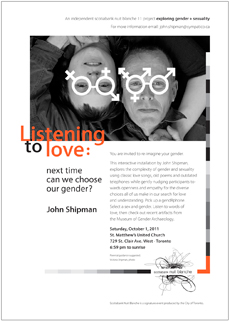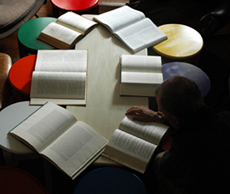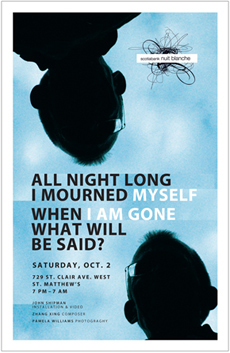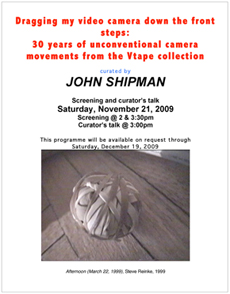Scotiabank Nuit Blanche 2011
 The following is a selection from the 100 written comments received from 441 visitors about the interactive multi-media installation about gender and sexuality: Listening to Love: next time can we choose our gender? that I presented at St. Matthew's Church, 729 St. Clair Avenue West, as part of Scotiabank Nuit Blanche Toronto.
The following is a selection from the 100 written comments received from 441 visitors about the interactive multi-media installation about gender and sexuality: Listening to Love: next time can we choose our gender? that I presented at St. Matthew's Church, 729 St. Clair Avenue West, as part of Scotiabank Nuit Blanche Toronto.
Visitor comments:
I have three daughters. Nothing but questions on my mind. How will I support them in their choices? How will I do? Thank you.
Interesting what combination I felt most comfortable listening to: woman to man which is the sort of relationship I'm in right now. The other combinations I wasn't as interested in what they were saying. Cause for thought...
Amazing. What a great way to start a necessary communication.
I like this. At first it was kind of cheesy, but really enjoyed it afterwards — felt warm and kind of oddly validating.
Fascinating that it was held in a church; almost ironic.
It is distasteful to put this exhibit in a church.
Another visitor responded to the comment above: That's the point. Open your mind. Loosen up! I love art and ideas in a church!
I love the way Facebook says we are in a relationship. It makes me laugh. Not because it's funny, but because it makes me happy [a quote from one of the gendRphone voices]. So good. I really enjoyed this — perhaps this will be my highlight at Nuit Blanche?
Beautiful. Everyone should have a gendRphone of their own — nice for the good days and the bad.
I loved the message and I loved the form the installation took. I loved the discussion with you.
So lovely... Such a treat to see another great project — I especially enjoyed sitting in a booth where everyone is connected through the shared inner circle.
The text on those little business cards is very well put. I took one... hope you don't mind.
I love the space and the setup. The music, the gendRbooths, they all struck a cord. And the art out front, it fit perfectly with the theme. The cards were a great touch.
Fascinating! Why were the voices automated / robotic? It seemed to deprive it of the emotional intensity I was expecting.
Wow! Great installation. Nicely designed/crafted, suits the space very well!
And from a child: Dear John, I liked the way you shoed girls and boys and it was very nice. I was cind of inspierd but again I didint reely know about it.
Read John Shipman at Nuit Blanche, a review by Heather Saunders
Originally posted 11 October 2011
Invitation: Joy Shipman



